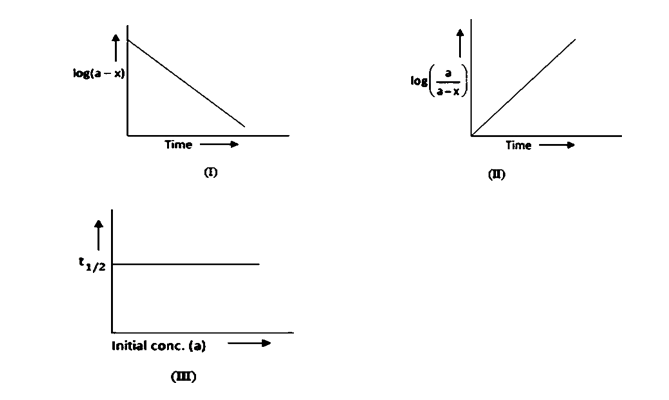In a first order reaction, reactant concentration 'C' varies with time 't' asSolution in Odia
C decreases with 1/t
log C decreases with 1/t
1C increase linearly with t
log C decreases linearly with t
The correct Answer is:d
Step by step video, text & image solution for In a first order reaction, reactant concentration 'C' varies with time 't' as by Chemistry experts to help you in doubts & scoring excellent marks in Class 12 exams.
Updated on:21/07/2023Topper's Solved these Questions
- CHEMICAL KINETICSBOOK - ARIHANT PUBLICATIONCHAPTER - CHEMICAL KINETICSEXERCISE - QUESTIOS FOR ASSESSMENT (Part III Integrated Rate Equations) Very Short Answer Type Questions
5 Videos
- CHEMICAL KINETICSBOOK - ARIHANT PUBLICATIONCHAPTER - CHEMICAL KINETICSEXERCISE - QUESTIOS FOR ASSESSMENT (Part III Integrated Rate Equations) Short Answer Type I Questions
5 Videos
- CHEMICAL KINETICSBOOK - ARIHANT PUBLICATIONCHAPTER - CHEMICAL KINETICSEXERCISE - QUESTIOS FOR PRACTICE (Part III Integrated Rate Equations) Long Answer Type Questions
11 Videos
- CARBOXYLIC ACIDS BOOK - ARIHANT PUBLICATIONCHAPTER - CARBOXYLIC ACIDS EXERCISE - CHAPTER PRACTICE (LONG ANSWER TYPE QUESTIONS)
3 Videos
- CHEMISTRY IN EVERYDAY LIFE BOOK - ARIHANT PUBLICATIONCHAPTER - CHEMISTRY IN EVERYDAY LIFE EXERCISE - CHAPTER PRACTICE (LONG ANSWER TYPE QUESTIONS)
2 Videos
Similar Questions
A ...... dependent equation of rate is called differential rate equation.
View SolutionThe rate constant for a reaction of zero order of A is 0.0030 mol L−1 s−1. How long will it take for the initial concentration of A to fall from 0.10 M to 0.075 M?
View SolutionDerive an expression for the rate constant of first order reaction. Give an example of first order reaction.
View SolutionConvert
(a) the benzoic acid to benzaldehyde
(b) the propanone to propane
View Solution(a) With the help of an example explain how do tranquilizers act as antidepressants?
View SolutionIn a first ordr reaction, reactant concentration 'C' varies with time 't' as
View SolutionIn a 1st order reaction, reactant concentration C varies with times t as:
View SolutionWhich of the followin ng fraphs represent a first order reaction (a= initial concentration of reactant, x= concentration of reactant consumed, t = time) ?
View SolutionPlot a graph of concentration of a reactant at time t, [ (a-x)] against time for a first order reaction .Here a = initial concentration of the reactant an x = change in concentration of the reactant at any time 1 during the reaction.
View SolutionFor a first order reaction, the concentration of reactant :
View SolutionWhich of the following is/are correct for the first order reaction ? (a is initial concentration of reactant, x is concentration of the reactant reacted and t is time)

View SolutionC_(o) =initial concentration of the reactant C_(t) = concentration of the reactant at time t, k=rate constant of the reaction. Then the equation applicable for a first order reaction is
View SolutionIn a first order reaction fraction of the total concentration of the reactant varies with time 't' is equal to
View SolutionWhich of the following graphs represent a first order reaction (a=initial concentration of reactant, x=concentration of reactant consumed, t=time)
View SolutionA reaction varies independent to the concentration of reactant, then the order of reaction is:
View Solution
